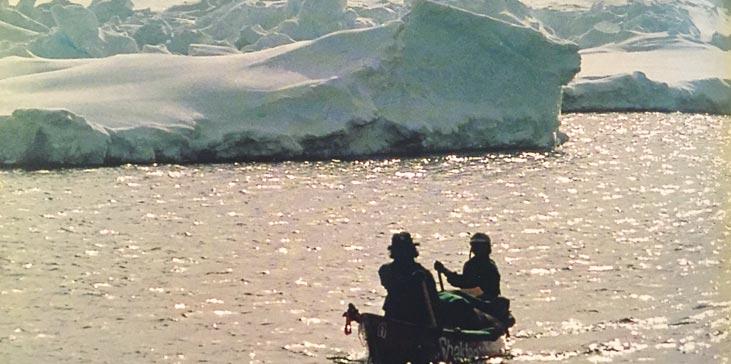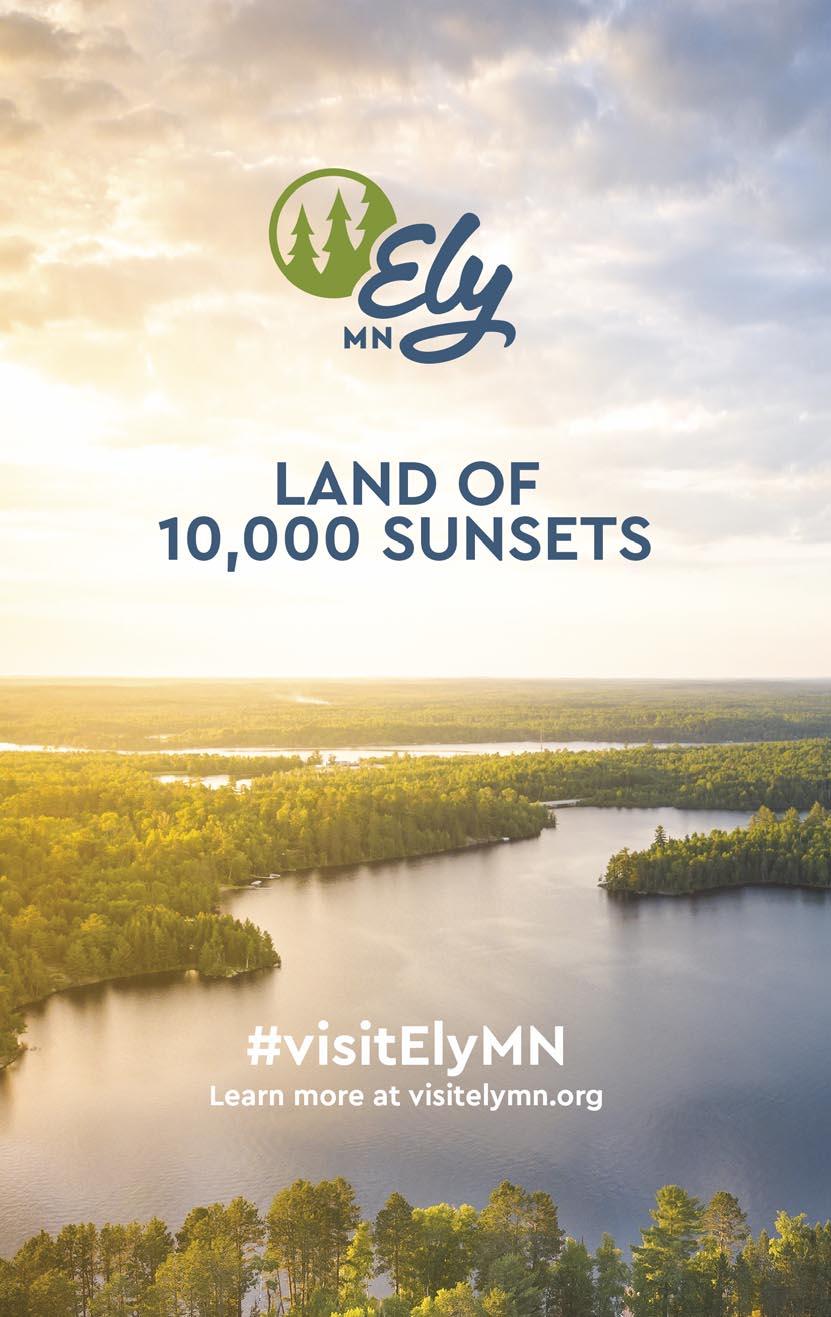
45 minute read
Isabella Trails
Old Trails, New Management
The Flathorn-Gegoka trail system has been the premier wilderness trail in the Isabella area since 1971 when it was developed as part of the Environmental Learning Center and CCC camp. For the past 60 years it has been maintained and groomed by National Forest Lodge staff, guests, and volunteers.
Last winter the Lodge was purchased by a private party not currently running the property as a business, but with enthusiasm for keeping up the trails for hiking, biking, skiing, dogsledding, and some ATV use. And so Friends of the Flathorm-Gegoka Trails was created to arrange for grooming, keep signage up to date, make maps available, and sponsor trail maintenance parties.
The 13 miles of trails are the most remote and wild in the state outside the BWCAW, and users are likely to see signs of wolves, moose, and bears as well as more common boreal species. Huge pines and picturesque views are plentiful along trails that are suitable for beginning skiers, although guests should have some knowledge of travel in remote wilderness.
The easiest way to find maps is to Google Flathorn Gegoka. For anyone interested in joining the Friends, contact flathorngegokaskitrails@gmail.com.
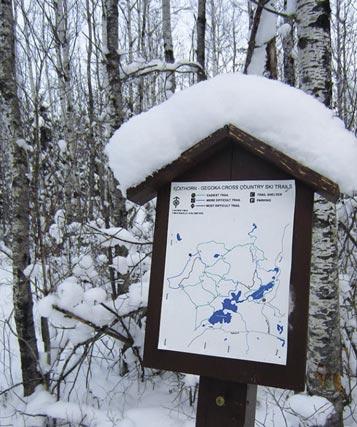
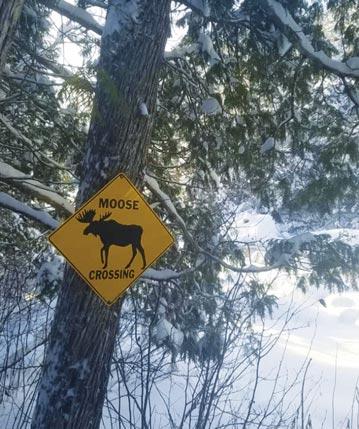
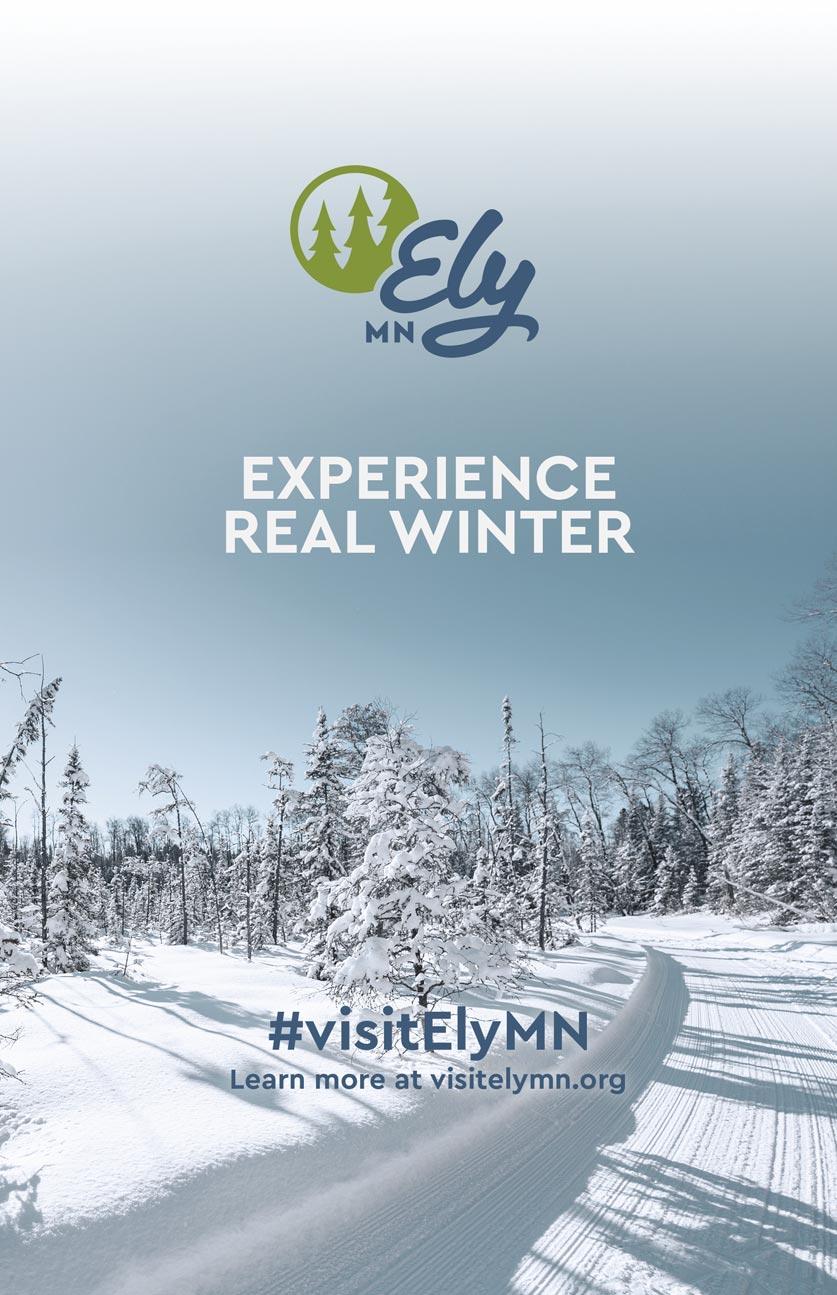
WINTER SURVIVAL REPAIR At Joe’s Marine & Small Engine Repair Chainsaws, snowblowers, generators. Mechanics are on duty and parts are in stock. 25 W. Chapman St., 219-365-6264

Maps of the Ely Area
Little Free Libraries are available for taking or donating books.
4 5 3 17 18 20
7 6 10
12 11
9
Central Av. 13
15 16
14 21 22 27 28
26 29
25
24
23
Conan St.
1st E
Camp St. Downtown Area
31 32 33
30 35 37
34 36
Chapman St.
Harvey St.
38
4 Ave School
Sheridan St.
Whiteside Park
Art & Soul Gallery & Gifts 33 Brainstorm Bakery 30 Brandenburg Gallery 17 Chapman St. Bookstore 21 City Hall/Fire/Police 25 ECHC Free Clinic 38 Ely Area Credit Union 9 Ely Bike and Kicksled 4 Ely Bloomenson Pharmacy 2 Ely Clinic and Hospital 2 Ely Community Resource 38 Ely Field Naturalist Res. Ctr 11 Ely Folk School 27 Ely Public Library 24 Ely Steak House 26 Ely Surplus Store 4 End of the Road Yoga 10 Evergreen Cottage 22 The Front Porch 31 Healthy Families Chiro. 16 Insula Restaurant 20 J&L Hardware 14 Joe’s Marine & Repair 7 Kekekabic Studio 14 Mealey’s Gift & Sauna 3 Mike’s Liquor 32 Northern Grounds 6 The Pebble Spa 28 Piragis Northwoods Co 5 Prairie Fire Tobacco 21 Post Office 23 Potluck Kitchenware 16 Senior Center 13 Sisu Yarn Shop 7 State Farm 12 State Theater 29 Save the Boundary Waters 16 WELY Radio 21 Wintergreen Northern Wear 27 Women’s Wilderness 32
Semer’s
Park 54 Chandler St. W.Shagawa Rd. 55
Hwy 169 to Tower 3rd W
Hospital & Clinic 52
See Detailed Downtown Area Map on Page 39
2nd W 1st W Central Av 1st E
50
Golf Course 69
Miners Lake
Miner’s Dr.
56
Camp St.
Sheridan St.
Chapman St.
Harvey St.
Conan St.
White St.
Pattison St. 6 Ave
School
Ice Arena Public Landing
55
Washington St. 58 Main St.
Madison St.
60
Whiteside 8 Ave 61
10 Ave 12 Ave
James St.
Boundary St. Wilson St.
Hwy 21 toBabbitt Beacon Hill
Arrowhead Outdoors 64 Dorothy Molter Museum 73 Ely-Bloomenson Hosp./Clinic 52 Ely Liquor 57 Ely Nordic Ass’n 72 Ely Rec Center, Skating Rink 58 Ely Tourism & Chamber 67 Ely-Winton History Museum 66 Evergreen Restaurant 68 Gators Grilled Cheese Emporium 61 Grand Ely Lodge 68 Hidden Valley Recreation Area 72 International Wolf Center 71 Miners Dry, Arts & Heritage Ctr 69 Northland Paranormal 60 Pillow Rock 59 R & R Transfer Storage 74 Recycling Center 53
Snowmobile trail maps are free at many businesses and the Chamber of Commerce. For snowmobile events and trail conditions see the Ely Igloo Facebook page. Ski and snowshoe trail maps are available at Piragis Northwoods Co. and the Forest Service. For more area XC skiing info see www.ElyNordic.org.
74
14 Ave 15 Ave 65 55
75 17 Ave Vermilion Community College 66 Savoy Rd 55 Hwy 88 November 1 through May 31
Park on the North or West side on odd numbered days, the South or East side on even numbered days. You may park on the next day’s side after 6pm.
67 64
63
53 Sheridan St.
Cemetery 73
Hwy 1 to Airportand North Shore 70
71 Hidden Valley Rd. Hwy 169 to Winton/Fernberg Trail
Kawishiwi Tr
72
LITTLE FREE LIBRARIES
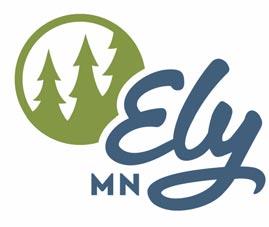
Studio North
75 Trezona Trail 55 Wolf Track Classic Start 63 USFS Visitor Center 70 VCC Admissions 66 VCC Theatre 66 Veterinary Clinic 56 Zup’s Grocery 65


81 82
Burntside Lake
Hwy 169 Echo Trail
WINTON
Fall Lake
95 Hwy 88
Shagawa Lake
93 94
Ely
87 83 88
Kawishiwi Tr 89
Hwy 21 85
84 Hwy 1
86 White Iron Lake
90 92
Fernberg Garden Lake
Farm Lake
91
Alder Place 85 Babbitt & Embarrass 85 Bear Head State Park 81 Camps Du Nord and Widji 82 Chilly Dogs Sled Dog Trips 84 Flathorn-Gegoka Trails 86 Kawishiwi Falls 88 Koschak Farm 94 Lamppa Manufacturing 81 Nordic Home Gifts 81 North Arm Ski Trails 82 St. Louis Co. Landfill 85 Silver Rapids Lodge 89 South Farm Ski Trails 91 Veteran’s on the Lake 83 Voyageur Outward Bound 86 White Wilderness Dogsled 86 Wintergreen Dogsledding 90

The Ely Dining Guide
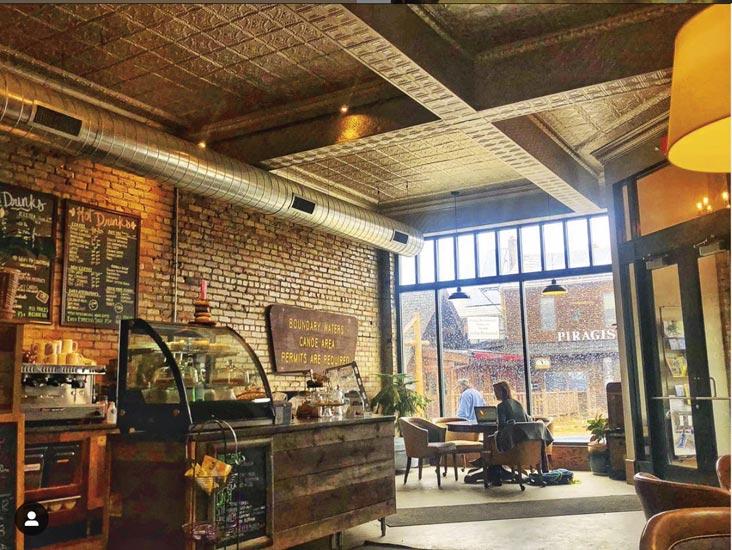
Ely restaurants are still struggling to hire enough staff. Many have reduced hours from their pre-Covid days. Some close temporarily if staff test positive for Covid. As has always been the case, winter hours vary through the season. So it’s best to call to check on current hours. And please be nice to those who show up to work. A generous tip can make their day, and help pay their rent.
$: dinner entreés or a full meal, C: children’s menu, # location on the maps pg. 31-34 All Ely restaurants have gluten-free choices. Hours may vary. The Boathouse • Ely’s only brewery serves seasonal brews and hearty food in the family dining room or bar. Duck wings, steak bites and other appetizers. Burgers, Cuban and beer brat sandwiches, walleye and chips, or the winter weekly special. Winter-only piled-high pizza. Beer in growlers to go and BW containers. Big TVs, full bar. 47 E. Sheridan St., 365-4301 $10-19, C
Brain Storm Bakery • Did you have a crappy morning? If not yet, stop on in and add some healthy fiber to your diet with locally made, mostly organic granola, yogurt parfaits, smoothies, cookies, and fair-trade coffee. Buy extra for gifts in pun-filled packaging. Bumper stickers and T-shirts too. Local artists’ displays. New place at 402 E. Sheridan, 235-6161 $5-8 V #30
Ely Steak House • Steak dinners, walleye, seafood, chicken, and French onion soup prepared to perfection. Prime rib on Fri and Sat. Senior discounts 4-6 pm. More than 1/2 a million Bucky Burgers have sold–the most popular burger in Ely. Generous servings. The lounge is a favorite night spot with games and specials. 216 E Sheridan, 365-7412 $12-$40. C V #26

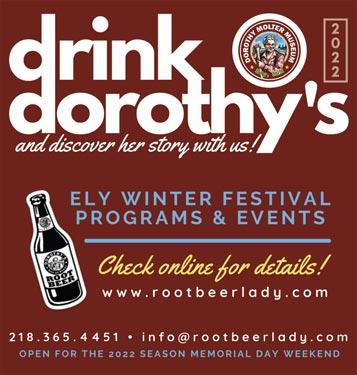
Evergreen Restaurant & Antlers Lounge • at Grand Ely Lodge. Extensive
dinner menu, b’fast and lunch specials, light dinners and appetizers. Pasta specialties, salads, walleye, and steaks. Vikings games specials in the bar and lobby. Easy snowmobile access. Open 365 days a year. 400 N Pioneer Rd, 365-6875 for reservations and take-out. $10-26 C V #68
Front Porch Coffee & Tea Co • Open daily at 7 am, this is the place for organic coffee, espresso drinks, chai, and fair-trade teas–hot or iced. Also wraps, burritos, soup, salads, quiche, and delicious desserts. Browse area newspapers, use the book exchange. Kids’ area with toys. Indoor or outdoor seating. 343 E Sheridan St, 365-BEAN $5-8 C V #31
Gators Grilled Cheese Emporium • Breakfast and lunch comfort foods and healthy alternatives, homemade pizza, turkey avocado sandwiches, burger specials, and salads. Little Free Library inside, cozy fireplace, and amusement for young restless diners. Homemade pasties monthly; see Facebook for dates. Closed Feb-April 955 E. Sheridan St, 365-7348 $7-16 C V #61
Insula Restaurant • This popular dining spot serves many locally-sourced and organic ingredients in the New American cuisine for lunch and dinner. Featured plates daily. Expand your palate with fresh flavor blends, or choose old favorites. Casual-dining ambience. Specialty cocktails, beer, and wine. 145 E. Sheridan St, 365-4855 $9-32 C V #20



Northern Grounds • Coffee and wine bar. Espresso, single-origin coffee roasted fresh daily, tea, chai, mocha. Soups, sandwiches, and marketplace charcuterie items, fresh-baked bread and pastries. Wine by-the-glass, craft beers, and specialty cocktails on tap. Wednesday Wine Society tastings. Register @TheNorthernGrounds.com. 2 W. Sheridan St.. 365-6162 $6-10 V #6 Organic Roots • Natural Food Market with organic fresh produce and organic foods ready to go or enjoy in the intimate lunch setting. Seasonal menu changes daily with vegan and gluten-free options. Flatbread specials, gourmet soups and sandwiches. Deli counter with wraps, salads, and healthy baked goods Open every day. 141 E. Chapman St. 365-2799 $5–16 V Oriental Orchid • More than 100 authentic Vietnamese and Chinese menu items for take-out or eat-in. Dinner combinations for 2, 3, or 4. Curries, spring rolls, wonton or egg drop soup, sweet and sour entrees, seafood dishes, and much more. Their specialty is soft rice noodles. Call for faster service. Take out or eat in. 506 E. Sheridan St, 365-7502 $9-$19 V


Sir G’s • Italian cuisine in a space with artistic murals of old Italy. The pasta is made by hand right there, and they season their own meat for flavorful fillings and delicious meatballs. Plenty of pizza options. Expanded appetizer menu with wings. Save room for the Italian desserts. Wine and beer. Take-out (call ahead). 520 E Sheridan, 365-3688 $10-19 C V
Stony Ridge • Ely’s biggest burger selection (50 kinds!) plus appetizers, chili, salads, and a full bar. Specialty stuffed hashbrowns on breakfast days. These generous folks will offer Ely Area Outreach again this winter, providing free cheeseburgers and fries to people in need. Bring your appetite! Dinner M-F, Sat breakfast, lunch, and dinner. 60 N. Laneview, 235-9441 $13-40. C
Winton Roadhouse • Open daily with 3-6 pm traditional happy hour and 8-10 pm late night bar food specials. MN Mixology Mondays with Mollie. Woman Wednesday drink specials for women. Live music on Fridays. Karaoke on Saturdays. Soup and sandwich specials on Sundays. Epic loaded Bloody Marys all weekend. 252 Main St, Winton, 365-3339 $6-10
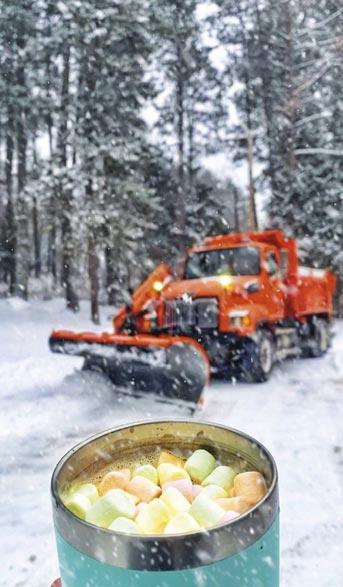
Bar Food Beyond Peanuts
Pizza and more...
Catz Billiards - 29 E. Chapman Dee’s Bar - 17 E. Sheridan Kwazy Wabbit - 11 N. Central Samz Place - 1203 Old Winton Rd. Silver Rapids Lodge - 450 Kawishiwi Tr. Zaverl’s Bar - 509 E. Sheridan
Fast Food Options
Dairy Queen - 1441 E. Sheridan (closed for a bit around the holidays) Log Cabin Coffee - 1340 E. Sheridan Subway -1520 E Sheridan Zup’s Deli - 1500 E. Sheridan
Support The Ely Winter Times Thank our advertisers!
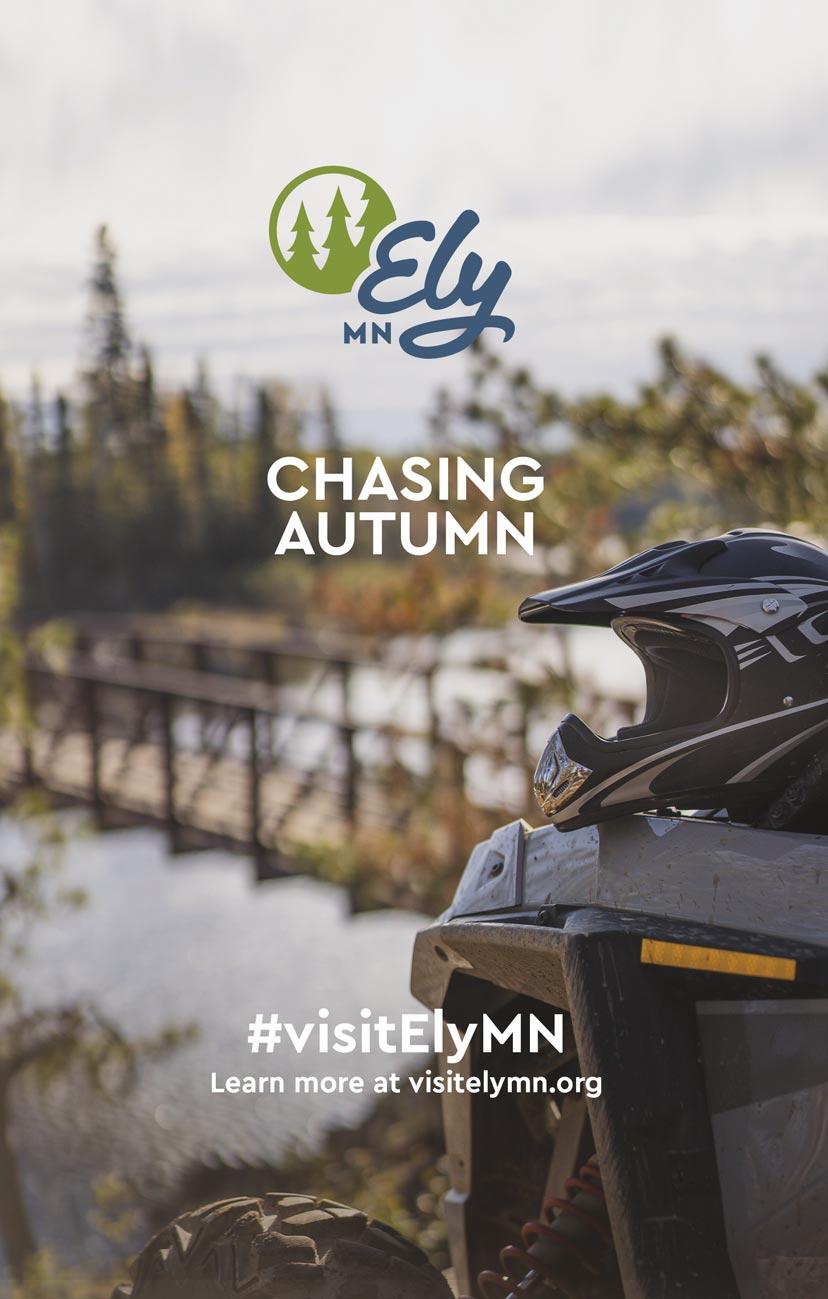
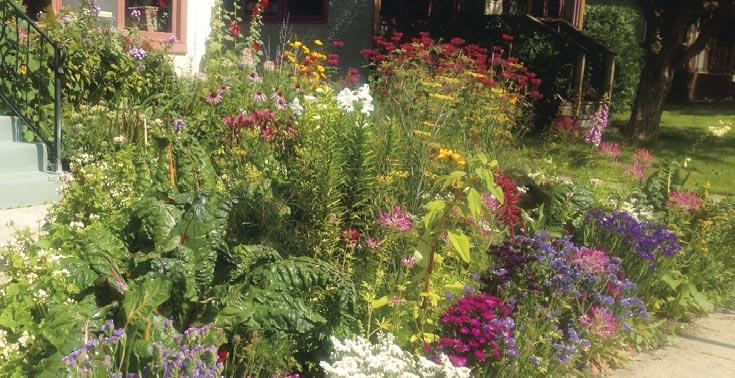
In Case You Haven’t Heard...
Do you want your yard to have a spot like this next summer? A place that’s not only beautiful but also an important source of food and breeding habitat for pollinators? Lawns to Legumes (L2L) is ready to help. In addition to information on how to help pollinators through your gardening efforts, they are offering a grant of up to $300 to individuals willing to plant a small pocket pollinator garden in their yard, switch to a fine fescue lawn with low-growing flowers, create a meadow-sized area with native plants, or add flowering trees and shrubs to their landscaping plans.
The grant money can be used to purchase materials or hire contractors and must be matched by a 25% contribution to the expenses, which can be in the form of the recipient’s labor at $25/hour. Applications for grants must be filed by February 15, 2022. Selection of recipients is random, but partly based on locations that are a priority for supporting the more than 450 bee species and hundreds of other insects that pollinate Minnesota’s plants. There are three priority levels, and much of the land surrounding Ely is in the Priority #2 category.


There are some rules, including avoiding pesticides, maintaining the project for at least three years, and choosing a variety of plants to ensure that there are blooms throughout the season. Even if you don’t want to apply for the grant, you can be inspired by the Pollinator and Biodiversity Toolbox, project layouts, plant and insect lists, photos, and more at BlueThumb.org.
You probably heard about the Greenwood Fire, but if you haven’t driven down Highway 1 lately, you might be surprised at the changes in the landscape. Fueled by drought conditions and an abundance of insect-killed balsam and spruce trees, the fire blew up on August 23rd, traveling six miles from Greenwood Lake to Highway 1 in just a couple hours. In the following days Highways 1 and 2 were developed as a fire break, meaning clearing along the roadsides that hadn’t burned to remove any vegetation that could serve as fuel if sparks and cinders dropped there.
Wild fires always involve different levels of severity. A light burn or ground fire moslty cleans up the dead branches and litter on the forest floor and may burn a little ways up the trunks of trees. Moderate burns leave a mess of charred logs, with many tipped over and crisscrossed making it difficult to walk through. A severe burn goes down to mineral soil. taking out all organic matter on the ground and leaving charred standing trunks. In any of these conditions theere can be danger from falling trees because tree roots may have burned leaving unstable snags that tend to tip over in a wind.
The Pitcha Lake Road and Dunka River Road will be good places to observe the natural recovery that follows

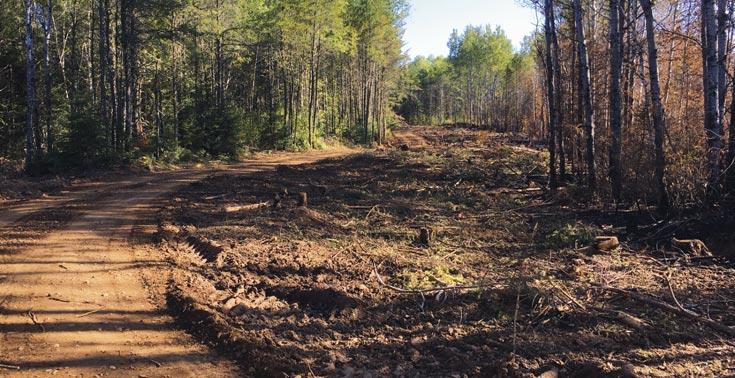

wildfire. Just days after the burn there are colorful molds growing on charred soil and stumps. After a week and a little rain or water from firefighters’ hoses, grass pops up. By next summer there will be mats of fire-adapted herbacious plants like wild geranium and bindweed along with tree seedlings–especially jackpine and aspen depending on the soil type and what was growing there before the fire. It’s a fascinating process and watching it will be easy with the Forest Service roads and ATV trails in the area.
A film is coming out soon, sponsored in part by Firewise, about Indigenous knowledge of wildfire’s healing role. You can watch a trailer at Vimeo.com; search for Oshkigin: Spirit of Fire.
There has been plenty of change in Ely’s retail world, but one you may have missed is the little log cabin next to Wintergreen. Northern Toboggan Company has taken over that charming space to offer classically beautiful, Minnesota-made snowshoes, toboggans, and sleds. Along with kicksleds, windblocking outerwear, sturdy winter boots, and backcountry skis, these can be purchased or rented.
Piragis Northwoods is another place to rent winter gear including skis and snowshoes, but also winter expedition equipment like tents, stoves, and pulks.
It’s a great opportunity to try before you buy, or if you live in warmer climes, to enjoy these northern sports in the way Elyites would rent a surfboard if they vacationed at a tropical ocean. Get out under the cerulean winter sky and find your happy Ely place.


Living a Language
Anishinaabe girls picking sweetgrass
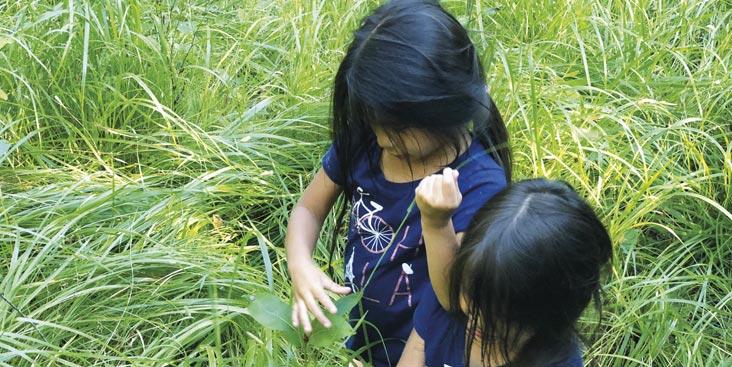
Story and photos by Ryan Bajan
Instead of Nina Moose, try Ninimooshay, and it means “sweetheart” in Anishinaabemowin. Anishinaabe is what the people also known as Ojibwe call themselves. Adding -mowin to the word means the language. Wisini is pronounced Wee-sa-nee, and means “eat.” Traveling through the Boundary Waters we encounter lake names deriving from centuries of inhabitants–Dakota, French, Ojibwe. The latter holds the most recent history of First Nations people who still remain, and the language, while not often spoken in homes, is still a part of their culture and traditions.

Consisting of more than 6,000 verbs, Ojibwemowin is a language that is tied to the land. It is an oral tradition language that wasn’t written until Europeans arrived and provided phoenetic spelling, which differed considerably from one person to the next. And so Ojibwe and Chippewa are different spellings of the same word. The language continues to add words as the world modernizes.
The content of the language was derived from reciprocal awareness of the provisions of the land: Who are we in being provided for by the land? And what is our responsibility back to the land? As such, the language uses a hierarchy of meanings and practices that emphasize how the thing being described is to be understood. For example, the word for Love is Zaagii. However the teaching of love as a core value, a Grandfather Teaching, is Zaagi’idiwin. The overall understanding of love as the most critical part of existence is Zhowendowsiwin, meaning something like unconditional love, the way we are to treat each other and the world around us. We do not do this in the English language, nor do we have a way to emphasize the importance or severity of the thing we are talking about without adding adjectives.
Ojibwemowin is a language that was structured to be grasped through the use of stories, legends, tales, and other oral teachings. In order to help it be taught and understood today, it has to be known in that context.Let’s say I want to learn about wild rice harvest in Ojibwemowin. There are books I can access that give much of the language around Manoominike Giizis (the wild rice moon or time of harvesting), yet in hearing the
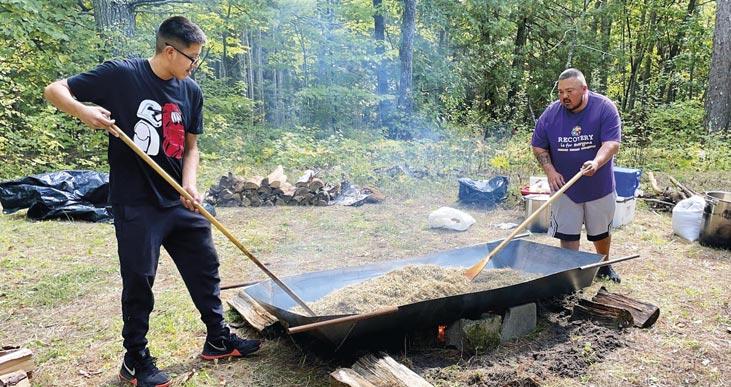

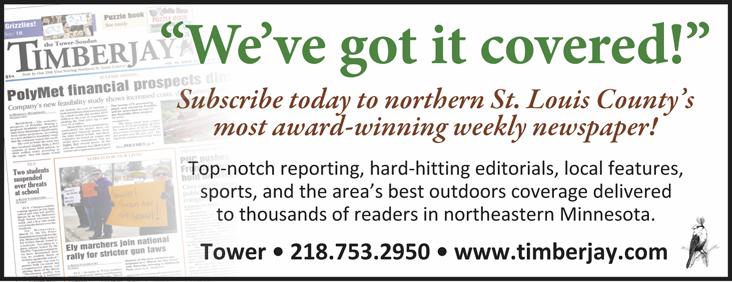
migration story which led the Ojibwe to the manoomin, cutting and crafting a gaadakii’igan (push pole) and bawa’iganaakag (knocking sticks), parching the manoomin in a kettle over a fire, and giving the rice away through feast, one gains a wholistic understanding of the language and the way it interacts with the noopiming (natural world). Separated by an arbitrary boundary, the Lac La Croix First Nation remains a part of the wilderness with close family ties to the Bois Forte Reservation. Deceased elder Ruby Boshey shared with me stories from her youth growing up in the Lac La Croix village. Long before a road existed into the reservation, she and her family would motor boat to Crane Lake and hop on the train to Duluth once a month. She said it took about a day to make it down there and a day back. Once the railroad stopped and border
The author’s students learn traditional skills like parchng rice
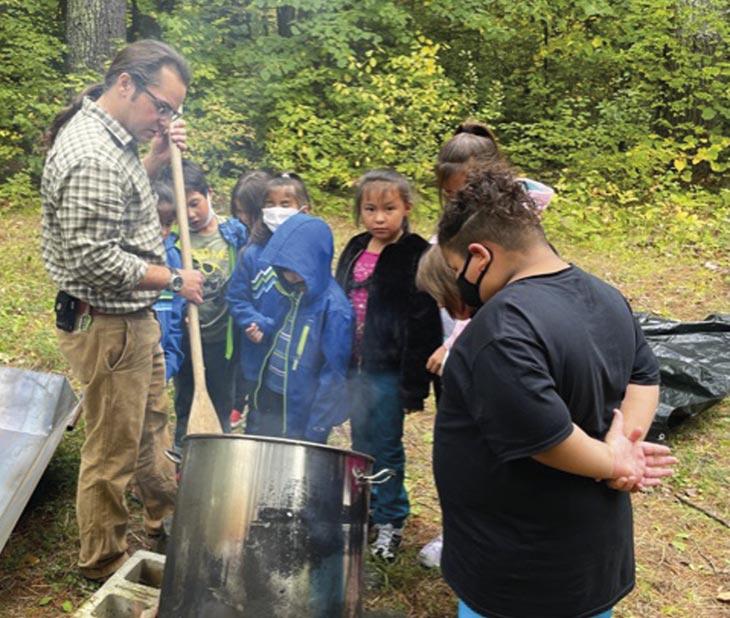
laws became more stringently enforced, people started leaving the reservation because it was too hard to travel and stay connected to family. The Lac La Croix community that still lives on the lake continues to practice a traditional life of seasonal harvesting. Their main source of income is guiding anglers, but they sustain themselves with what the land provides.
Traditional ways are experiencing a renewal within the younger generation. Mino Bimaadiziwin is the Anishinaabeg worldview, meaning “The Good Way of Living.” This refers to living in a way of harmony and reciprocal appreciation of the natural world, nimaamaa-aki. This concept plays a major role in how Ojibwe communities view the roles of elders, adults, and youth. It dictates what makes an Anishinaabe person Anishinaabe, because if one is following Mino Bimaadiziwin then they are living in full appreciation of the land and its ability to provide. This means protecting the water, the forests, the fish, the game. It means that the community must provide for itself and teach its youth to become grateful providers for their families and elders. The Seven Grandfather Teachings, a series of values that are taught to us by nature itself, fall into this practice as well.
Language revitalization is most active in Minnesota and Canada. As firstlanguage Anishinaabemowin speakers are aging and dying, the language is used less and less. In most cultures language is simply handed down generation to generation because it is the basis of communication. But speaking and teaching the languages of Native Americans was forbidden by the dominant immigrant culture of the late 1800s and early 1900s. The major instrument of this challenge was the boarding schools that operated throughout this area and other areas with a significant Indian population. These residential and day schools worked at the removal of traditional knowledge and language. The damage from boarding schools’ oppression will take many generations to heal. The approach of making the language a priority in educating the younger generation requires the use of both modern technology and traditional practices. Apps, online classes, college courses, curriculums, and abundant websites make learning Ojibwemowin a reality for new learners. Stories told by
Some Students’ Thoughts About Studying Anishinaabemowin
The language is hard to learn, but I already know how to count, introduce myself, many animals, and other things. We try to use the language in my home, my mother and brother and I. My name is Ogema, and it means ‘little chief’. - Ogema, 4th Grade
One day I want to fully learn Ojibwe language. Learning it makes me feel connected to the Great Spirit, to Mother Earth, to my relatives. My siblings know a lot words and speak it in the home. My favorite part of the culture is going to powwows and dancing. - Dennis, 5th Grade I want to learn more about my culture, that’s why I want to know the language. Its been fun learning about the natural world, like plants and animals, and being able to call them in Ojibwe. My grandma teaches us about the Medicine Wheel and tells us stories. I have a name in the language, given to me after a dream I had. I’m trying to connect more to my culture and learn more. - Violet, 5th Grade
It’s been hard learning the language. Its spoken sometimes in my home. I want to learn the language though. - Savannah, 5th Grade

elders are equally important. This is most impactful when youngsters can sit down with the elders, but such sessions are also being recorded to use in future efforts at retaining not just the words of the language, but also the spirit. Bois Forte KBFT radio is one group working hard at this task.
Just as the language continues to live, the traditional activities are still ongoing in the region. At Nett lake school, students from Nett Lake Reservation attend Ojibwe culture classes up to five hours a week. Every season brings a traditional camp, following the full moon cycle and in accordance with local ceremony protocols. It was recently Dagwaagin, Fall, and students completed the manoomin, wild rice, harvest with a Miigwech Manoomin ceremony and celebration. This followed a week-long traditional camp with parching, threshing, and winnowing using the traditional techniques. The next camp is Waawaashkeshi Gabeshiwin, or Deer Camp. Students learn how to process a deer, preserve the meat traditionally and in modern fashion, as well as how to use the parts of the deer such as the hide,
You don’t need Native heritage to enjoy picking blueberries


antlers, and intestines. Spring will bring a traditional maple sap harvest camp, Iskigamizige Gabeshiwin. Throughout the school semesters, students regularly spend class time outside, rekindling a keen awareness and reciprocal respect for the natural world. The Bois Forte tribe research reveals that student attendance, class performance, and overall behavior have improved since restarting traditional programming.
Borders, war drafts, treaties and their mishandling, smallpox and flu, boarding schools, and relocations have certainly made an impact on the survival of the Ojibwe language. I recall something Kelvin Ottertail, now gone on, shared at a Grand Portage Pow-wow years ago. He said, in Ojibwemowin, that the language is not disappearing, that it is always right there. We just have to remember it, to find it in the woods and lakes; even the animals will teach us again. His meaning was that it is the traditional life that brings the words back to us.
Maybe the next time you fish on the Kawishiwi, hike the Kekekabic, or paddle on Ogishimuncie, you will recall that there is still a living language and a people who remain tied to that land. Get to know them. Attend one of the ten annual powwows in the area next summer. Check out powwows.com and KBFT.org, and read the Bois Forte News at boisforte.com Visit the Bois Forte Culture and Heritage Center at Fortune Bay. It will deepen your understanding of your own experience on the land. We all love to help you to live Mino Bimaadiziwin. Ryan Bajan teaches Ojibwe language and culture at the school on the Nett Lake Reservation. You can read his blog at maaiingan.blogspot.com.
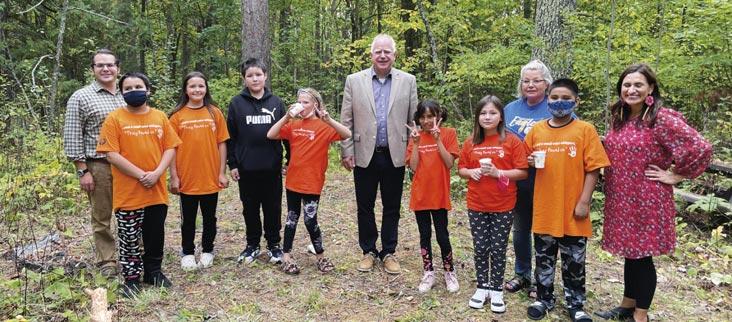
The Retrievers
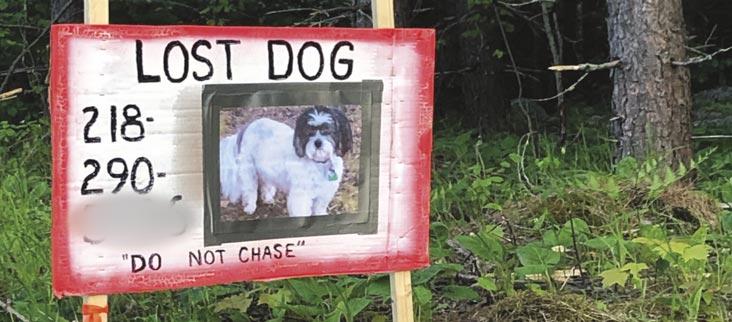
DOG and HUMAN are out for a hike on a trail near Ely when HUMAN needs to stop to tie her shoe.
DOG: Something smells really exciting over here. I gotta go see.
HUMAN: Where did Rover go? He was here just a few minutes ago.
DOG: [Panting] Gotta go a little farther, the smell is stronger over this hill.
HUMAN: I’m sure he’ll be back in a few minutes. I’ll go on slowly.
DOG: Yikes! It’s a squirrel! Gotta chase... across this swamp, over this log, through this brush, up this tree. Oh, I can’t climb trees. I’m sure this squirrel wants to meet me. I’ll sit and wait for it to come down.
HUMAN: Gee, it’s been 10 minutes. I’d better go back and see if I can find Rover. [Walks back 100 yards or so.] Hmmm was this the spot I tied my shoe? Or was it a little farther? Rover! Come!!
DOG: I guess the squirrel doesn’t
want to play, and I’m ready for a treat. Now where was I? Where’s my human? HUMAN: Maybe he went back to the car. I’ll go there. DOG: I don’t smell my person. UhOh. I smell something that might want to fight. Or eat me. I’d better run downwind. Gee, I didn’t know I knew how to evade a predator. I’m feeling wild, but scared. HUMAN: He’s not at the car. I’ll go© Lisa Foss back and call. DOG: I’m scared. I’m hungry. I’ll tuck my tail and watch out for scary things. HUMAN: [Tromping through the woods and calling loudly] Rover! Come!! Come right now! Rover! Rover!! DOG: There’s an animal making a lot of noise. I’d better hide. And so DOG and HUMAN don’t find each other. DOG has reverted to feral instincts to survive a dangerous unfamiliar place. HUMAN’s instincts are to yell and chase. This is not going well.


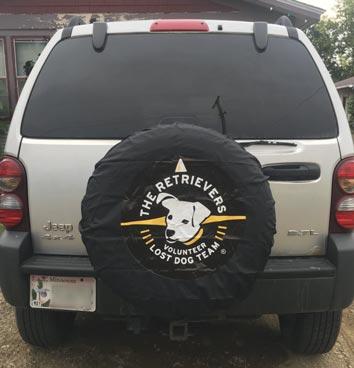
There are many different ways that dogs get lost. One of the most common is a dog being adopted from a shelter or another owner. Before the dog becomes bonded to its new people or familiar with a new home, a chance for escape occurs: a walk from the car to the house, an open door, a gap in the fence. Car accidents may leave a dog scared, possibly injured, and without supervision. And some dogs are just natural rovers, eager to run and explore when they get the chance, unconcerned about whether they can find their way home. This can be heartbreaking for the dog’s human family who consider the dog a full-fledged member of their household.
The Retrievers is a non-profit, nationwide (although most active in Minnesota) organization dedicated to helping families and lost dogs reconnect. Much of the help Retrievers provide is teaching dog owners what to do when their dog is missing. Because a lost dog reverts very quickly to survival mode (also called lizard brain), chasing and yelling only drive it farther away. Many owners have reported that on being reunited with their dog, the pup didn’t seem to recognize them at first, no matter how closely they were bonded before the separation.
Ely is lucky to have one of the Retrievers, Lisa, living right here. Lisa’s first case happened before she was an
© Lisa Foss
Rear View of Lisa’s car
official Retriever. An Australian Cattle Dog mix named Lindsey was on a canoe trip in the Boundary Waters with her family–a father with his three daughters. As they were packing up to leave, Lindsey disappeared. The family hung out, called and called, and finally had to head for home. They reported the dog missing at TheRetrievers.org, then headed back to the Cities. Meanwhile another group of BWCA travelers found the dog and were able to catch her and bring her to their home on the east end of Ely. They called the owners, who were ready to jump in their car and come get their canine companion, but had to stop when the dog took advantage of an open door to bolt. The Ely folks, knowing Lisa was a dog lover and caretaker, called her, and the Minneapolis family called The Retrievers.
Kathy, an experienced Retriever from Grand Rapids, arrived in Ely within a few hours, and she and Lisa began putting up signs at intersections. The Retrievers know exactly what to include on signage and, just as important, what to leave off. The dog’s name doesn’t get posted because people tend to yell the dog’s name if they spot it, which just makes a lost dog more wary. Remember–they are in a wilder state than their domestication would lead us humans to believe possible.
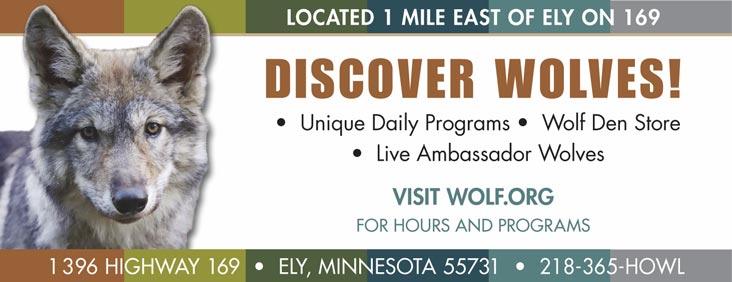
Calls about Lindsey started to come in right away from sightings near the Chamber of Commerce. Kathy and Lisa set up food stations and their special trap, called a Missy Trap, that is spacious and baited with smelly food. When the dog enters, the door shuts by means of a Raytripper–a device that releases the door when the dog enters and breaks a beam of light. The person monitoring the trap, either at the location or on their cell phone, comes immediately to minimize the trauma of being in a trap. But Lindsey never showed up and didn’t appear on the trail cams set nearby. Kathy had spent the better part of two days in Ely and had to return home, so Lisa was on her own.
Another call came from a person who had seen Lindsey run across the Fernberg Trail–Oh no!–being chased by a wolf. “Well, that’s it,” thought Lisa. “End of story.” Lindsey wasn’t a big dog–just a snack for a wolf. But more calls came from farther up the Fernberg, so Lisa moved the signs and food stations past Winton. The next call was a few days later when a student at the Outdoor Learning Center spotted Lindsey on a hill close by the classroom building. Lisa went there right away, and her daughter Jen followed with the trap, cameras, and more food. Lindsey was apparently watching the whole set-up from close by. When Lisa and Jen left, a call came almost immediately. Lindsey was secure in the trap!
Lindsey and her family were reunited. Lisa was hooked. She didn’t need much additional training because this case taught her most of what she needed to know: first, spread the word. Call law
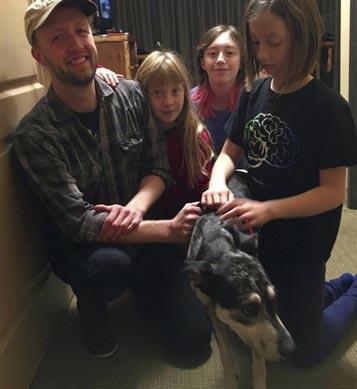
© Lisa Foss
Lindsey on the canoe trip
2021-2022
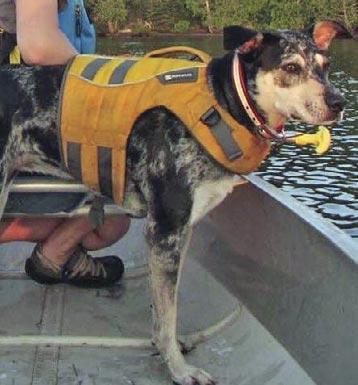

enforcement for the area as they are often the first ones to receive a call when a stray dog is found, so can match up the lost and found reports. Next put up lots of big signs at intersections near where the dog went missing, and create social media posts that will be read by residents there. This should all be done within the first few hours, when it is much more likely a dog is still in the vicinity where it was last with its human.
Next, put out items with the owners’ smell or even the dog’s own smell–dirty T-shirts or the dog’s bedding are good choices. As time passes, the dog is likely to get hungry. Smelly items such as cat food, fish, and rotisserie chicken work well. Make a food station and set up trail cameras to document the dog’s visits. (Be aware other critters will be attracted. Adjustments may need to be made. Dogs like peanut butter, but coyotes don’t. Bears like everything.)
Put up more big signs and re-post on social media. Create a large wagonwheel-shaped scent trail using liquid smoke, with the food station at the center. When the dog crosses the large outer circle of the wheel, the spokes will draw it in to the food. Don’t drive around looking and calling. A lost dog is not likely to be found by spending precious time on that after the first few minutes. It’s much more urgent to get the word out and respond to sightings.
One early May, a retiring Ely sled dog was adopted, but escaped almost immediately through an open door. The mushers who knew and loved her began searching, using the resources they found on The Retrievers website. They brought other dogs this lead dog had known and liked, and hiked the trails near where she was last seen. Trail cams were set up and big smelly food stations were put out, attracting the biggest bear that the astonished searchers had ever seen. WELY broadcast the news and the What’s Up Ely? Facebook page became active with possible sightings. Unfortunately, several of the sightings were other dogs who just happened to be loose. But more reports suggested this former lead dog was heading out the Kawishiwi Trail. The searchers alerted resorts, homeowners, hikers, ATVers, and even outfitters hoping someone would see her. They paddled the Kawishiwi River, Farm, and Garden Lakes and hiked dogsledding trails off the Fernberg and Spruce Road. After four days the reports stopped and hope started to dwindle, but the mushers pressed on, trying to guess what route this dog would take to get back to her kennel and traveling what they hoped was her path.
It was a group traveling in the Boundary Waters that finally spotted her, deep in the wilderness area. She’d been gone 10 days and was tired, weak, hungry, and cold, resting on some matted grass next to shore. Having been briefed by Ely Outfitting Company on what to do, the paddlers marked the area nearby with bright colored P-cord, avoided disturbing the dog, and called WELY. The mushers traveled to the spot, getting close but not too close, and the one whose lead dog she was stepped out of the canoe and sat a little ways away from her. As the musher looked at this dog that had been her lead dog and affectionate companion on countless trips, she could see that the dog didn’t even recognize her. The musher’s clothes were laden with kennel scent, and she
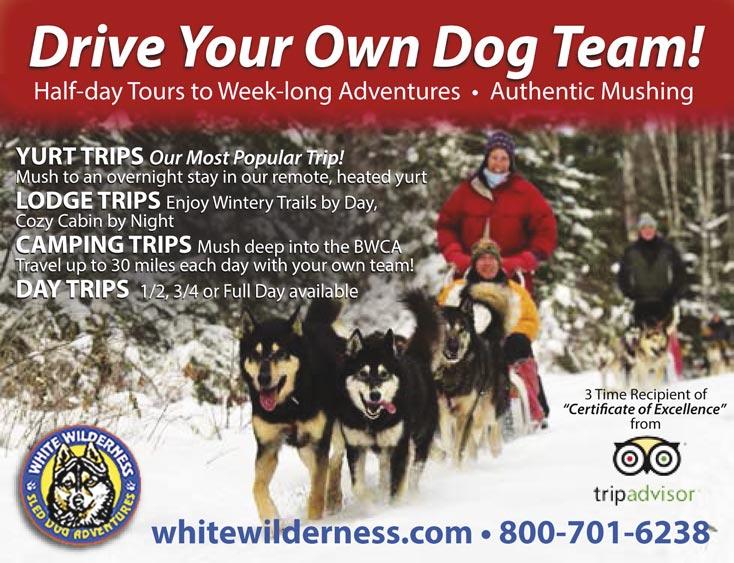
A happy ending for a musher and her lead dog carried hot dogs and chicken, but the dog avoided contact. Until the wind shifted, carrying some of the scents with it. The dog’s nose twitched, she turned toward the musher, sniffed again, and ran and jumped into the musher’s lap. What a happy reunion! Sometimes scent seems to restore a lost dog’s memory in a way nothing else does.
How long can a lost dog survive? Those that don’t make it are most commonly killed on highways or railroads, or they drown crossing bad ice. Wolves and coyotes are not often the cause of their demise. Sasha was a Great Pyrenees–Golden Retriever mix, a big girl who had grown up on a farm with goats and chickens and several other dogs. When her owner had to go to a nursing home, Sasha went to a shelter where she was adopted by a nice older couple. Her new owners stopped at Walmart to get her a leash and food, drove to their house a ways west of Tower, and opened the car door to introduce Sasha to her new home. She took off immediately.
The couple called The Retrievers and
53


they all tried their best, but after five days the reports of sightings stopped coming in. They moved the signs east to the Y corner and Fortune Bay, then had a few sighting reported close to Tower. Then Eagles Nest. Then even closer to Ely. Then nothing for a while. Eventually some Eagles Nest residents called to say they were seeing this dog about every three days. A pattern emerged indicating Sasha was making a loop from Eagles Nest to Tower, into the back country around Lake Vermilion and Burntside, and back to Eagles Nest. Lisa set up a big food station and Sasha was seen on the camera visiting. So Lisa set up the trap. Sasha never approached that food station again.
Time went on and it was getting cold in late fall. Lisa’s food stations were freezing so the smell didn’t travel as well. She set up another trap down a dirt road with lots of fresh warm food, drove a halfmile away, and parked at the side of the road. A movement caught her eye, and she looked up to see three deer trotting across the road. A few minutes later, Sasha came walking slowly past her car. Lisa watched her trap camera on her cell phone and was amazed to see Sasha walk right into the trap and start eating the food. The trap closed and this dog was finally rescued after five weeks surviving on her own. She was down to about 70 pounds from her usual 100, but she was alive. And the best part–she was immediately adopted into a new home with an older dog, and it was love at first sight for all of them.
54
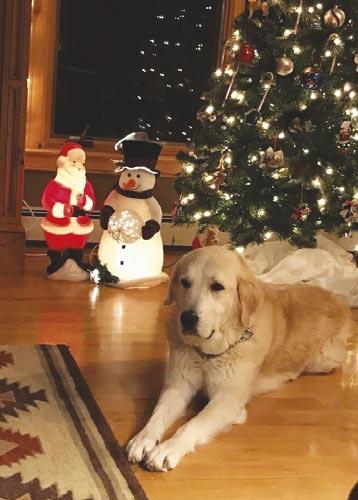
© The Retrievers
WHAT IF YOUR DOG IS LOST?
Check The Retrievers’ Website for the best advice. Spread the Word - signs, social media posts, law enforcement. Tell residents and others in the area where the dog was last seen. Don’t Chase and Yell!
www.TheRetrievers.org
© Suzi Jackson

Books for Blizzards

We like to claim author Sarah Stonich as our own, partly because she lived in the area for many years, but even more because she creates scenarios and characters that feel local in the best sense of the word. Readers from other parts of the world might think Fishing is very creative fiction, but we know similar characters live here and it’s likely that real events were the basis for Stonich’s stories. Superficially hilarious and light, the episodes of RayAnne’s all-woman fishing talk show still reaches a depth most humorous books don’t achieve. You might even pick up some angling tips on board Penelope, RayAnne’s classic speedboat, as you meet the quirky guests and eccentric production crew. Or maybe you’ll find some helpful relationship advice as you follow the tangled romances and familial drama. Plus there are the life lessons from Dot, RayAnne’s beloved grandma who is a strong presence in both books, but as a ghost in Reeling as she follows RayAnne to New Zealand for the second season. There’s some cross-cultural fun but the Minnesota flavor prevails. Whether you’re from Ely or afar, you’ll be glad there are two novels because you won’t want the first one to end.
Speaking of grandmas, our favorite pick for the kids this winter is Grandmother’s Pigeon, a wonderful book that has been out of print for years.

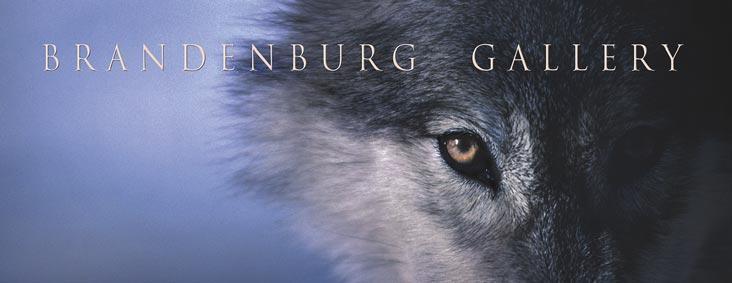


When Grandmother leaves on an adventure, her two grandkids discover something mysterious and wonderful happening to a stuffed pigeon in her bedroom. The kids struggle with choosing the right thing to do about this, but eventually hit on the best solution and carry on with their own adventure. Along the way they, and young readers, learn a bit about the extinction of passenger pigeons. Luminous illustrations add an extra tug on the heartstrings. This is a book that adults will be glad to share over and over, which is good because children are going to be asking for it many times. Our favorite gift cookbook for the season is The Good Berry Cookbook. Although there are some berries in the recipes, “the good berry” refers to manoomin, wild rice. The author, an ethnobotanist, shares stories from her Anishinaabe family life, instructions for foraging in different seasons, and recipes from her own kitchen as well as from chefs from other Native nations and traditions. She takes readers to the fields and forests to marvel at the wealth of healthy foods and medicines growing wild around us. We return home able to cook up a quick Bison and Sunchoke stew, or Nutty Manoomin Patties, and a nutrient-dense Fiddlehead-Nettle sauce. Many recipes, like Sweet Potato Corn Pudding with Rose Sauce, can be


Chapman Street Books Quality used books on all subjects. Bring yours in for a discount. Big free box. Home to Prairie Fire Tobacco, with imported and domestic blends. 139 E. Chapman St. 218365-2212
prepared with ingredients from the grocery store or farmers market. If you give this as a gift, you’ll want to get one for yourself too, or live close enough to your lucky gift recipient that you can share.
Loon Lessons is a deep dive into the ecology, biology, and behavior of the common loon. If you have a question about loons and the answer is known, chances are very good you’ll find it in this book. Written in an entertaining style with plenty of anecdotes illustrating the research data and scientific information, the book covers details about breeding, migration, physiology, calls and their usage, winter life, and loon conservation. Color photos at the center illustrate plumage at various seasons, other species, and chick-raising activity.
Skiing Into the Bright Open is much more than an account of the first woman’s solo trip to the South Pole. It is an inspirational example of perseverence in fulfilling a lifelong dream despite
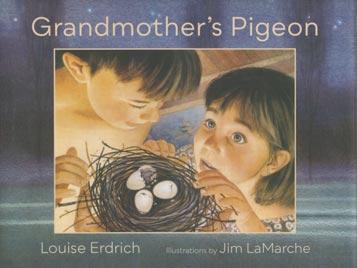

Enjoy Canoe Country all year with The Boundary Waters Calendar!

$13.95 at your favorite stores, by mail, phone, or online
+ $6 per shipping address. MN delivery add 6.875% sales tax.
PO Box 188, Ely, MN 55731 • 218-365-3375 • www.RavenWordsPress.com 2021-2022 57



frequent bouts of self-doubt, limited support from places one might expect it, a need to gain the confidence required by big expeditions, and enormous physical obstacles. For the author there is no joy equal to skiing across a bright white open space. But crossing Greenland, hiking the Himalayas, and striving to feel prepared for Antarctic travel provide plenty of challenges to meet before those magic moments of brilliant light and easy motion. This humble telling of a remarkable accomplishment makes for a good read in a cozy spot, watching winter out the window.
Gichigami Hearts tells stories from an Ojibwe perspective of the Duluth area starting with the formation of the massive gabbro outcropping know as The Point of Rocks and continuing to the author’s family history living near this landform for the past 200 years. A blend of the amusing and the tragic, the spiritual and the embodied, the indigenous and the immigrant, these stories portray life lived in the light of Anishinaabe ways. Whether native or not, readers will gain perspectives of the land and peoples and their intimate connectedness.
Joy abounds in Josie Dances as a young Ojibwe girl prepares for her first pow-wow. There is so much to do, but with her parents’, aunties’, and community’s help Josie overcomes her anxiety and learns to dance with her feet and her heart. A colorful book with a positive message for all children.
Contact to learn more today!
WhitePineProductions.net jacob@whitepineproductions.net


Ely Stories
Whether you’re born-and-raised Ely or just getting to know the place, you’ll become more intimately familiar with some Ely folks on the podcast, “My Ely Story.” Like sitting down for a longlasting cup of coffee, listening in on these chats provides a variety of perspectives on life here at the End of the Road. From senior citizens who have spent eight decades or more in Ely to much newer faces, each person adds their distinct flavor to the soup pot that makes up this community. And like a big potluck dinner, there is something for everyone and the socializing is as important as the content.
Brett Ross is the producer and host of these programs. Well known as WELY’s manager and DJ, Brett moved to Ely at the urging of his in-laws, who lured him with the notion that “Ely has more stories per square inch” than most places. Once he lived here, that description came to life for him. Now he is relishing the opportunities this podcast creates to have in-depth conversations with the people who hold those stories. The podcast is free wherever you get them.
Capturing some Ely history that could be lost as the older generation passes on and revealing the personalities behind the current character of Ely, the podcasts delve into the lives and opinions of people you may have heard of or know casually.
For instance “that crazy guy in the jeep” is Seraphine Rolando. Who hasn’t seen him driving around town with the jeep accessorized with a mounted machine gun or staged at the mine ready to share Ely’s history with anyone who stops by? Some who don’t know Seraphine may think the gun indicates an aggressive nature, but in the podcast you come to learn that it is simply an indication of his interest in WWII history and propensity to collect unusual antiques.
Seraphine once hoped to start a museum and, although that never came to pass, has accomplished something similar at the Pioneer Mine across the road from Grand Ely Lodge. He has
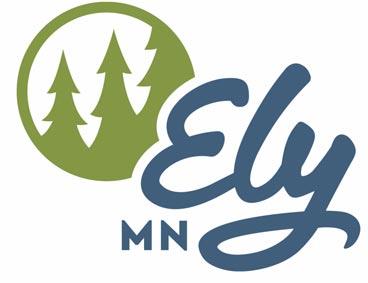

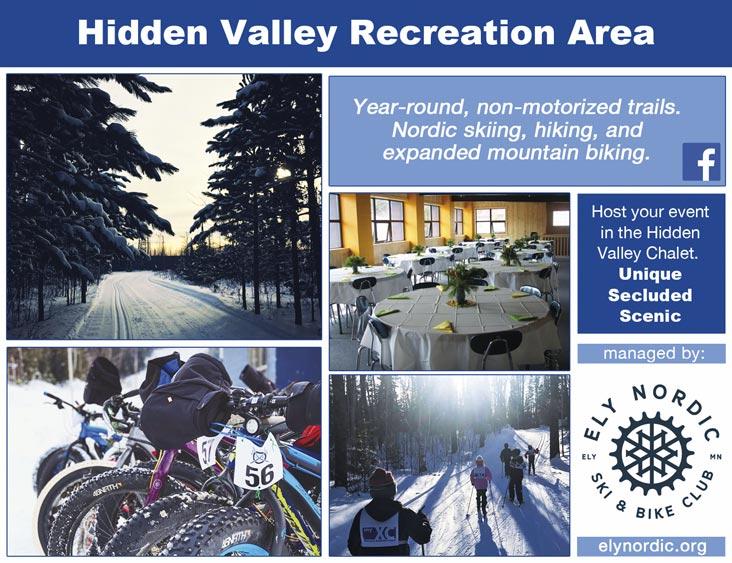
collected material and created displays of Ely’s mining history that include hundreds of photos of the miners at work, equipment and clothing used by miners, tools and machinery used to extract ore, and plenty of newspaper articles written about the mines and laborers. “Ely wouldn’t be here if it weren’t for mining,” he insists. All this is on display at the Shaft House, where you can visit with
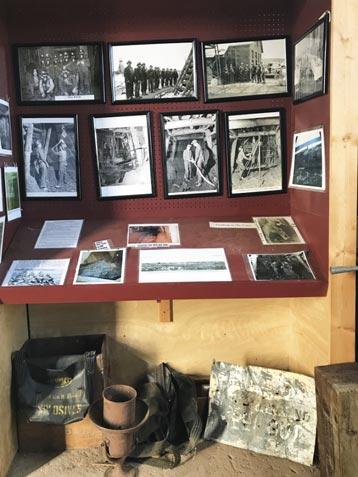

Seraphine anytime you see the jeep on the premises. But why wait? You can listen to him tell about Ely in the old days right now on My Ely Story.
You can also hear Shaun Chosa elaborate on his amazing life split between Ojibway culture and more common American ways. Shaun is a renowned artist and all-around creative soul who chooses to call Ely home. In his conversation with Brett he talks about growing up on Basswood Lake, where he spent every summer of his youth. With a 12-foot row boat, a mother and grandfather who taught him some basics then let him run wild, and all of Basswood Lake for a playground, he went barefoot every day from early spring until fish netting season was over in fall. His stories of this part of his life will delight anyone who enjoys Basswood. In fall Shaun had an abrupt transition to city schools in a variety of states and settings–almost 20 different schools before eighth grade, on reservations and in inner cities. These stories explain some of Shaun’s wideranging interests and abilities.
Shaun credits his start on the creative side of his life to his mother being an art school student when he was a toddler. He always had the materials he wanted to draw, paint, sculpt, or develop his own ways of creating art. His mother, grandfather, and an uncle taught him the skills and culture of his native heritage. Eight years in the Marines gave him another perspective.
A view of life in Ely you won’t want to miss comes from Julie Hignell. With Julie’s story you’ll hear about experiences as distant from Ely as a person can get and as close to the heart of Ely as anyone comes.
Julie was a biology teacher when she first came to Ely. Her interest was shifting
Julie ready for Arctic trekking

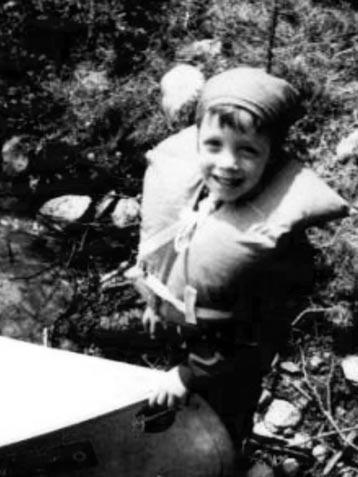

from human biology to ecology, so she took a job as a reasearch assistant studying bears and deer at the Kawishiwi Field Station. When the funding for that ended, she began working at the nearby Outward Bound school. She had a long career there as program director for both the summer and winter courses and was instrumental in starting the use of sled dogs for winter programs.
Then came invitations to participate in adventures in the Arctic and even Antarctica. You’ll have to listen to the podcast to hear about her journeys and training expeditions in Siberia, dogsledding to the North Pole, and leading Russian teen-agers on a winter adventure.
Now Julie is the director of Ely Community Resource, an organization that strives to ensure that every schoolage child in Ely has a positive social and academic experience growing up here. This part of her story will make you glad you live here, or if you don’t, wish that Julie lived in your town.
Brett welcomes suggestions for stories to include in the My Ely Story podcast. Surely you’ve already thought of several people whose stories you’d like to hear, or perhaps recalled stories of your own you’d like to share. Conversations are held in a low-stress living-room setting. You can reach Brett to share your ideas at Contact at VisitElyMn.org

Julie and a teammate crossing the Arctic Ocean. They switched from dogsleds to canoes due to open leads.
